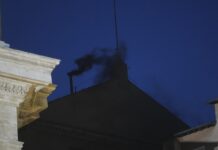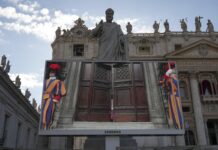
At 656 feet long and big enough to haul more than 4,000 automobiles, the hulking Golden Ray ship has been hard to miss in the St. Simons Sound, where it laid on its side for more than two years.
Now, after years of setbacks from oil spills, a fire, hurricanes and a change in contractors, a salvage crew is working to remove the last section of the South Korean car carrier.
This means the Golden Ray’s head-turning presence off the Georgia coast since September 2019 is nearing an end.
But environmentalists say the removal of the ship only clears the part of the wreckage most obvious on the surface. They are pressing for more details on what will come next to clean marshes and shores of the remaining oil and other contaminants that aren’t so visible.
Conservationists are concerned that agencies like the Georgia Department of Natural Resources might not require an in-depth analysis of the harm to invertebrates and up the food chain, other wildlife, and the local economy.
Fletcher Sams, executive director of the Altamaha Riverkeeper, fears the clock is running out before government agencies declare that there isn’t a need for a comprehensive investigation.
“It’s a no-brainer in my book,” Sams said. “It’s just ensuring that the resources on the coast which contribute in very large parts to the economy are intact in the future. I really feel like without a full assessment, it’s going to be hard for the stewards of that resource, the state Department of Natural Resources, to tell the public that everything’s safe with a straight face.”
Since the Golden Ray capsized in 2019, a Unified Command made up of salvage contractor Gallagher Marine Systems, the U.S. Coast Guard and the state natural resources department has overseen removal of the wreckage and environmental response plans.
The massive car carrier set sail for Baltimore out of the Port of Brunswick in the dark of night on Sept. 8. Federal investigations found vehicles loaded incorrectly caused the top-heavy ship to list allowing seawater to gush in an open door. All 24 crewmembers were rescued.
‘Lot of healing that needs to be done’
The environmental response to leaks from the Golden Ray included collecting water samples, testing air quality, cleaning up oil along the shorelines and collecting debris in emergencies. Data collected on water and sediment along with surveys of the sound and the marsh will be used as a baseline to determine a successful cleanup, according to the Unified Command website.
“It’s never too late to do it because this is an ongoing problem. And I really feel we have years to go before we even see healing, especially if there is oil on the bottom of our rivers and our estuaries. There’s a lot of healing that needs to be done, and that’s only going to take time. – – Susan Inman, One Hundred Miles coastal advocate
State and federal environmental agencies continue conducting natural resource damage pre-assessments throughout the wreck removal. Any decision regarding further remediation will be made by trustees appointed by Gov. Brian Kemp.
“Once the final section is removed and all potential sources of pollution have been mitigated, the state and other federal trustees will evaluate injuries as defined under the (Natural Resource Damage Assessment) process to determine if these injuries require further action and potential compensation,” a DNR commissioner’s office statement said.
Like Sams, Susan Inman, coastal advocate for Brunswick-based environmental group One Hundred Miles, is making the case for a formal damage assessment, even as the cleanup winds down along with a third hurricane season since the ship capsized.

“It’s never too late to do it because this is an ongoing problem,” Inman said. “And I really feel we have years to go before we even see healing, especially if there is oil on the bottom of our rivers and our estuaries. There’s a lot of healing that needs to be done, and that’s only going to take time.”
Over the last week, crews worked to get one of the ship’s final sections placed onto a barge to take to a facility near the Georgia Port Authority’s Mayor’s Point Terminal at Brunswick. The ship’s scraps are taken on a 1,200-mile trip to a Louisiana recycling facility.
“Lastly, as we finish the transload of Section Six and prepare to lift and remove the final section of the wreck, we continue a response posture that monitors for and will rapidly mitigate any potential debris and oil discharges,” U.S. Coast Guard Petty Officer Michael Himes wrote in an email.
“At the same time, our assessment teams continue to survey over 190 miles of shoreline from the air, on the water and by foot each week,” said Himes, the spokesman for Unified Command.
Local officials question assessments
Inman said the cleanup seems mostly focused on removing debris, such as car parts that fell as the ship was sliced into sections. The shipwreck was named to the Georgia Water Quality “Georgia’s Dirty Dozen” list soon after it ran aground.

“No one is talking about contaminants, and that’s really concerning,” she said, referring to the oil from the ship, the fluids from the cars and even the lead paint from the ship.
Elected officials say they worry the environmental analysis will not be rigorous enough.
Brunswick Mayor Pro Tem Felicia Harris raised the issue of water quality monitoring at a recent commission meeting, when representatives from the U.S. Coast Guard and the command center gave a brief update and fielded questions from city officials.
“We don’t really know at this point what the actual damage is, could be potentially, or potential that could take place on our waterfront coming from the operations that’s pertaining to this particular incident,” Harris said.
“And so I asked that question proactively, so that two or three years from now, we won’t come back and say, ‘Oh, you found something that came from that piece of that wreckage being there,’” she said. “How proactive are we in looking at this and staying on top of this and monitoring this? Because remember now that’s our waterfront.”
Unified Command has collected water samples since the ship capsized and plans to continue until the removal process is complete. In response to Harris, Himes said the public can report oil sightings to the Coast Guard’s National Response Center hotline: 800-424-8802.
Commissioner Julie Martin also questioned how far out toward the ocean the salvage crew will collect debris.
“I was just wondering how someone fishing off of the St. Simons pier catches a whole fender system,” Martin said. “We’ve got huge tides. There’s a very dramatic pull with the tide. I’m not necessarily pointing fingers. I’m just trying to figure out how do you compensate for all of that over the last almost two years?”
In August, strong currents spread oily seawater beyond the retention barriers.
Himes said the hydrographic survey – which is like an underwater scan – will focus on the area near the wreck. There is an environmental protection barrier set up around the ship to try to contain oil and debris from the wreckage.
“While the hydrographic survey does not extend all the way to the shoreline, we’re fairly confident that the kinds of debris that is escaping the EPB is plastic in nature and therefore floats,” Himes said.
The plan, Himes said, is for a cleanup crew to stick around to collect what washes up on shore after the netting that was around the Golden Ray is removed.
“The way forward is that we want to leave this sound as close to the same condition as it was prior to the capsizing of the Golden Ray,” Coast Guard Lt. Commander Michael Metz told city commissioners.
“We want to make sure in accordance with the state that the beaches are as clean as we can make them prior to us demobilizing,” Metz also said. “And then after that, once the unified command and the state have come to an end to an agreement and have made the determination, all resources will be demobilized.”
Himes said the Ray’s barrier performed its job through complex circumstances that involved trying to contain pollutants with shifting tides and allowing marine life and removal crews to maneuver in and out.
“Even with all of the benefits of the EPB, we were sober in our disclosures to the public that wreck removal operations had the potential to produce fires, debris and oil discharges,” Himes said. “While each of those scenarios occurred, our response posture allowed us to quickly assess and mitigate any impacts to the environment as soon as it was safe for our personnel to access affected areas.”
But for Sams, July’s oil spill is another example of why it was a bad idea for the people in command of the salvage to switch contractors early on in an attempt to shave a month off the timetable. Two years are gone and the cleanup is ongoing. A hulking floating crane-saw still obscures the ocean view.
“They said they could carve one month out of the removal and I think that was an unacceptable risk to the Sound,” Sams said.
The Golden Ray shipwreck remains a costly venture for its owners and insurers with a trade industry magazine estimating in September it exceeded $842 million, well above the inflation-adjusted $597 million when the Exxon Valdez ran aground in Alaska’s Prince William Sound in 1989.
A recent ruling from the National Transportation Safety Board confirmed a 2020 Coast Guard investigation that the ship likely capsized because of an unbalanced load that was compounded by incorrect stability calculations.







